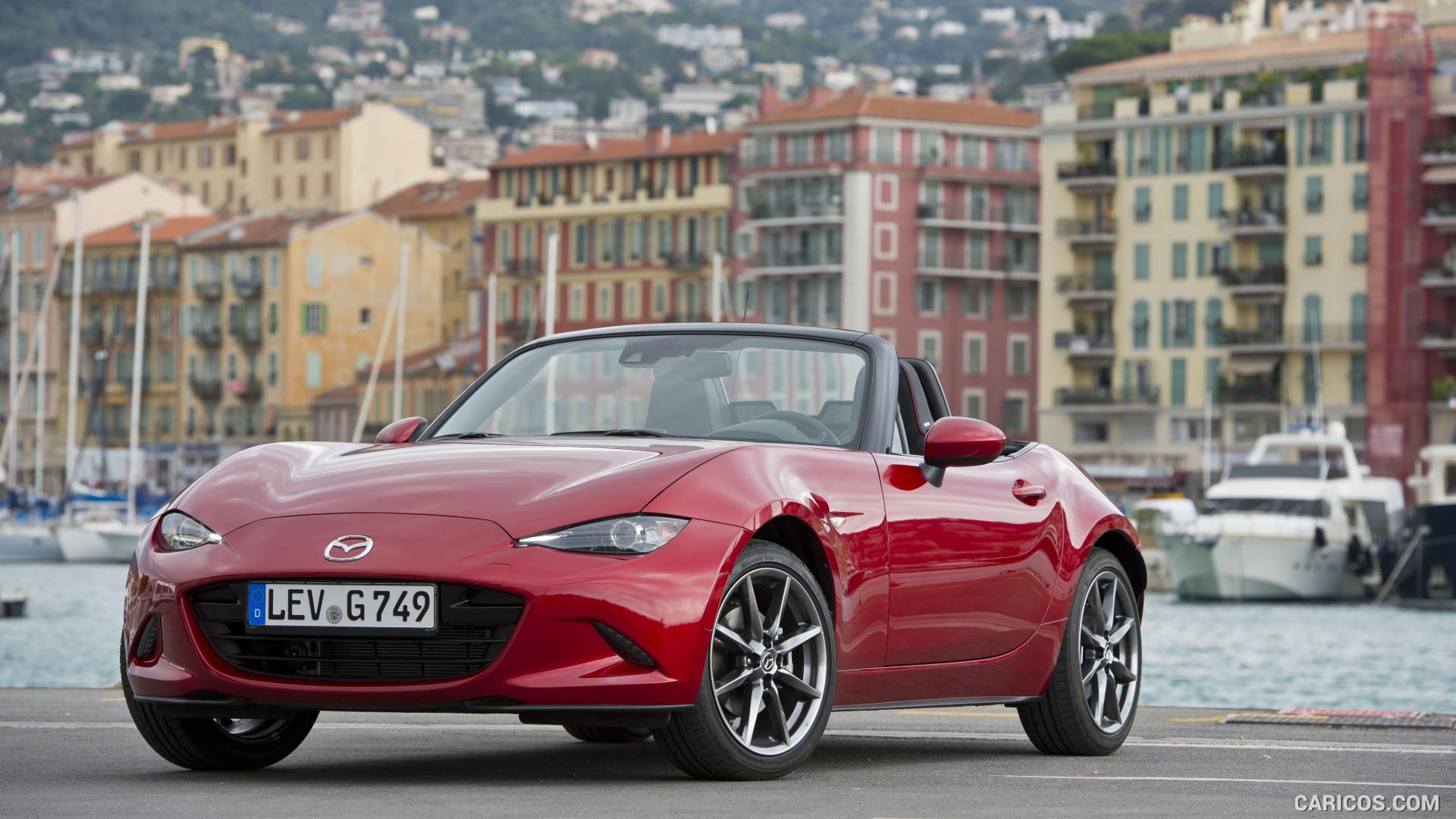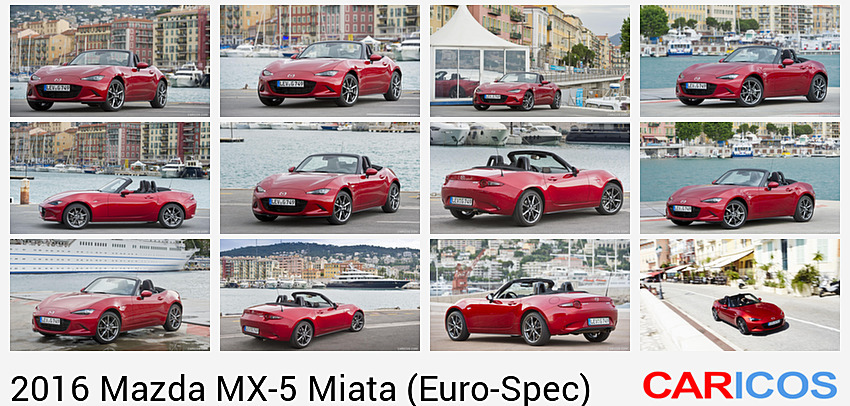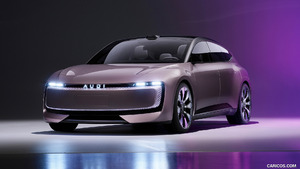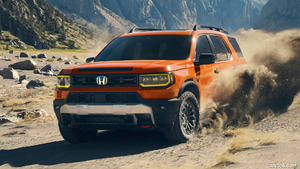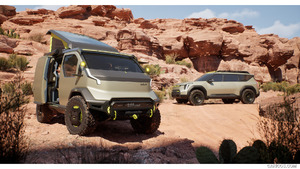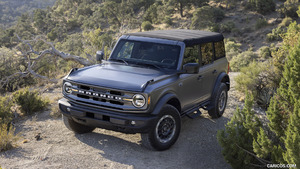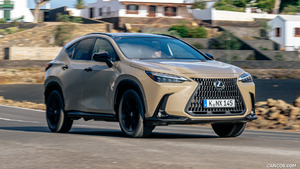Mazda MX-5 Miata (Euro-Spec)
MAKING MORE FUN A REALITY
MAZDA HAS SPENT MORE THAN 25 YEARS BEING OBSESSED WITH EVERYTHING A LIGHTWEIGHT SPORTS CAR CAN BE. ALL THE JINBA ITTAI INSPIRATION GAINED OVER THREE MODEL GENERATIONS HAS GONE INTO THE ALL-NEW MAZDA MX-5.
Its aggressive looks are, in a word, moving. Even at a standstill, the MX-5’s flowing KODO-inspired lines seem to be in motion. But it still looks best – as do those inside it – in its main element: Namely driving down the open road with the top down.
Jinba Ittai, the rider-and-horse-as-one-body doctrine that has defined the relationship between drivers and their MX-5 from the beginning, applies in more ways than one. For example, in the way the interior design and remarkably clever packaging of the fourth-generation model melt away the boundaries between the cabin and the exterior.
More traditional Jinba Ittai trademarks were also edged that much closer to perfection. Like weight distribution, which is now nearer than ever to the centre of gravity of a car that is lower to the ground with shorter overhangs. Starting at under 1,000kg*, the all-new MX-5 weighs some 10% less than the outgoing model and is the lightest since the first generation. And that in spite of the advanced active and passive safety, smartphone connectivity technology, and evolved ergonomics with a human-machine interface that enables the driver to make the most of it all.
The MX-5 was a source of inspiration for Mazda innovations like SKYACTIV Technology, since implemented across the model line-up. Now SKYACTIV comes home to the latest MX-5 with two specially modified high-compression SKYACTIV-G petrol engines, a SKYACTIV-MT manual gearbox that takes the roadster’s smooth, crisp shifting up another notch, a lightweight yet exceptionally strong SKYACTIV-Body, and a SKYACTIV-Chassis adapted to further enhance the already outstanding agility of Mazda’s icon.
One with its inspirations
It’s also safer, featuring i-ACTIVSENSE active safety systems and passive protection built into the SKYACTIV-Body and SKYACTIV-Chassis that is simply outstanding for an affordable roadster. Because peace of mind is also part of the fun.
And ultimately, pure driving fun is what the world’s all-time best selling roadster is about. The fourth-generation MX-5 is without doubt the most memorable edition yet.
DESIGN
LOVE AT FIRST SIGHT
THE ALL-NEW MAZDA MX-5 IS A HEAD TURNER – A DESIGN MASTERPIECE INSIDE AND OUT. IT REPRESENTS THE PINNACLE OF MAZDA’S EFFORTS TO CREATE A PERFECTLY PROPORTIONED LIGHTWEIGHT SPORTS CAR FOR A TRULY ELECTRIFYING DRIVING EXPERIENCE, ESPECIALLY WITH THE TOP DOWN.
The design starts with the people. After all, a roadster is meant to be driven with the top down, and driver and passenger are meant to be seen. That has been a key part of the MX-5’s allure for more than 25 years. Another is the patented Jinba Ittai driver-and-car-as-one feeling. Mazda’s KODO – Soul of Motion design for the fourth-generation MX-5 unites both concepts in a powerful visual expression of its essential character: quick, agile and above all fun to drive.
Exterior: Beautifully balanced
A hallmark of the all-new MX-5, perhaps more than any of its predecessors, is its ideal proportions. Occupants are seated literally at the vehicle’s midpoint, closer to the ground than in past MX-5s, reflecting the new model’s lower centre of gravity. The shortest MX-5 ever is also sleeker. Every single line and curve is intended to do one thing: set the onlooker’s heart racing.
At the front, the low-slung nose and short overhang hint at the car’s adept road-hugging proficiency. Sharp character lines running from the upper edge of the grille towards each headlamp emphasise the glinting nature of the wildcat eyes, which conceal ultra-compact four-lamp LED headlamp units. Situated at the lower corners of the front bumper, the LED daytime running lamps* underscore the MX-5’s broad stance.
Designers looked to the Japanese tradition of calligraphy when crafting the exterior, achieving a strikingly efficient flow down the sides of the car. Moving the cabin slightly rearward perfectly balances the roadster’s proportions with the top down or up. Matching the soft top, the black A-pillars, windscreen header, door mirror trim and seatback bars highlight the cockpit style of the cabin and robust top-down look. As for the soft top itself, besides stowing away neatly into a remarkably compact space and streamlining the MX-5’s silhouette, it also enhances the car’s overall appearance when up, not to mention its aerodynamics.
Teeming with uniquely beautiful forms, the sides of the body appear to be “tucked in” at the corners, also narrowing above the tires. Front or back, it all spotlights the MX-5’s design efficiency, with a low and wide trapezoidal outline front and back that further highlights its wiry musculature. The rear end, too, leaves a lingering impression. This is where all the lines converge through the flared fenders, which visually magnify the car’s volume. The rear combination lamps, meanwhile, give a nod to previous generations while at the same time reflecting Mazda’s unique new-generation lighting signatures.
The colours of unadulterated fun
The all-new MX-5 is available in seven body colours chosen to reflect pure roadster pleasure. They include Soul Red Metallic, the launch colour, and Ceramic Metallic, which changes hue depending on the lighting. The fourth-generation MX-5 can also be had in Arctic White, Crystal White Pearl Mica, Blue Reflex Mica, Meteor Grey Mica and Jet Black Mica.
Underpinning the new roadster are sporty 16- or 17-inch eight-spoke alloy wheels* with four-nut centre hub finished in either gunmetal or silver (16-inch) and gunmetal or bright silver (17-inch). Whatever the choice, they should resonate with driving enthusiasts: Made from coldcast aluminium, they’re both lightweight and durable.
The all-new MX-5 seems to erase the boundaries between the car, driver, road and scenery. For example, the ridgeline extending to the front fender from the upper door trim is the same colour* as the exterior, uniting inside and outside. The effect also underscores the traditional Jinba Ittai connection: It’s cosy as always in the MX-5, only now even more comfortable and ergonomic
Steering wheel: Classic, compact, chic
In true lightweight sports car tradition, the unpretentious steering wheel says “hop in and drive”. With a compact 366mm diameter, it features a black leather cover with red stitching and three satin chrome spokes matching the climate control dials and shift boot ring*. It works like it looks, too: On winding roads, the grip and rim facilitate quick, precise operation and hand-over-hand action, also letting the hands slide smoothly along the surface. The switches, meanwhile, are mounted inside the left and right spokes for easy access, recessed just enough not to interfere with operation.
* Depending on trim level
Interior: A second skin
A single axis in the cabin centres the driver on the steering wheel and instrument cluster in perfect symmetry with the climate control louvers to the sides and indeed all major controls, including the pedals and gearshift. Again here, the emphasis in the all-new MX-5’s cabin space is clearly on driving. These details boost comfort while preventing fatigue and reducing distraction potential.
And the details are many, from the compact steering wheel (see box) and ergonomic gearshift knob to the improved design of the soft top. It now features an assist spring reducing the force necessary for operation. The soft top is thus quickly opened or closed while remaining seated in an intuitive one-step manoeuvre – practical when the skies suddenly open up into a downpour.
The enhanced driving position offers occupants more knee room as well as head clearance. In fact, despite sitting lower to the ground, the driver’s field of view is greater on the all-new MX-5 than on the outgoing model in every direction: up, down and horizontally.
Completely redesigned, the elegantly detailed three-gauge analogue instrument cluster with satin chrome rings is centred around a large tachometer with the speedometer to the right and an information display on the left. The latter includes fuel and mileage indicators as well as a performance-oriented water temperature gauge featuring a wider range than previous models.
The symmetry continues along the sleek winglike dash, which stretches out horizontally to create a sense of roominess on the passenger side while further diminishing the boundaries between the MX-5 and its surroundings. The effect endures with the seamless flow of the panels into and along the trim of the doors. Their shapes express a dynamic pattern flowing from front to back. Highlighting the sculpted look, the soft material with decorative stitching on the armrests and central door trim sections contrasts pleasingly with the exterior coloured* upper-door sections.
The all-new MX-5 features high-quality sports car seats in leather or fabric that blend sophisticated beauty with maximal functionality (see box). Snug in longstanding MX-5 tradition, the cushions and seatbacks have a new net structure that enhances comfort, fitting occupants perfectly but still firm enough to hold them securely in place in tight corners.
clever enhancement, the luggage compartment of the all-new MX-5 is 35mm longer and 36mm deeper than its predecessor’s and can thus accommodate a pair of 550mm x 400mm x 220mm carry-on bags, despite the smaller overall boot volume of 130l**.
Upholstery: Refined, sporty class
The all-new MX-5 comes with a choice* of sporty black leather upholstery with red stitching or black fabric with either red or black stitching. Tan leather with beige stitching is also offered in right-hand drive models (UK only) for the authentic feel of a classic British roadster, while left-hand drive MX-5s are available with black Recaro seats in a combination of nappa leather and Alcantara® with red piping accentuating the seat edge. In all cases, the door trim and lower dash is finished in the same look.
The leather seats feature a pleat in the centre section with the diamond-shaped stitching used for the KODO Chair exhibited at Milan Design Week in 2013. The detailing and precision of the sleek three-dimensional appearance are another prime example of the craftsmanship that went into the roadster’s new interior. The grid-like woven pattern of the fabric seats, meanwhile, not only gives them a light, functional appearance, but also enhances body grip, fostering the Jinba Ittai feel.
* Availability depends on trim level and market
CONNECTIVITY, FUNCTIONALITY & EQUIPMENT
TUNE IN, TURN ON AND DRIVE
LIKE OTHER NEW-GENERATION MAZDAS, THE ALL-NEW MX-5 SAFELY AND EFFORTLESSLY CONNECTS DRIVER AND PASSENGER WITH THE WORLD AROUND THEM. AND WITHOUT DISTRACTING FROM WHAT MATTERS MOST: THE JOY OF THE ICONIC ROADSTER.
Mazda’s new-generation human-machine interface and smartphone connectivity play a central role in cabin functionality of the all-new MX-5. Important controls – the pedals, gearshift, steering wheel and rotary commander – have been thoughtfully designed and positioned to create that Mazda Jinba Ittai signature feel: As if the MX-5 were an extension of the driver’s body.
Based on the heads-up cockpit concept, the layout of the controls allows drivers to leverage a wealth of useful information from an impressive slate of advanced technology and still safely focus on the road. By emphasising greater usability via simplicity, developers enhance driving satisfaction.
An independent 7-inch display* is mounted on top of the dashboard of MX-5s with MZD Connect* (see box), Mazda’s smartphone-based system now available for the first time on an MX-5. Drivers can use the rotary commander on the floor console (or voice command for many functions) to effortlessly control the MX-5’s infotainment offerings shown via the display. The driver need simply to lower one hand from the steering wheel to the centre console-based control in one quick, easy motion without taking his or her eyes off the road. Many infotainment functions are also accessible using voice command, including the audio system’s play, stop and skip functions or to zoom in and out of the navigation system’s map displays. All audio systems, meanwhile, support DAB (Digital Audio Broadcasting) as well as RDS. The display itself is ergonomically positioned at the ideal height and distance from the driver. The screen thus minimises visual distraction, allowing for safe enjoyment of media, communications and online content.
Visually aligned
The instrument cluster, too, received a complete redesign with a large analogue tachometer between the speedometer on the right and another display to the left with the fuel gauge, fuel consumption, water temperature and other vehicle information. Logically, urgent safety system warnings appear in the tachometer. In “line” with the perfect driver-oriented symmetry of the MX-5 cabin, the centre of the instrument cluster is on the same axis as the middle of the steering wheel.
BOSE® PREMIUM SOUND SYSTEM
MAZDA AND BOSE® HAVE TEAMED UP TO DEVELOP A PREMIUM SOUND SYSTEM* TAILORED TO THE ALL-NEW MX-5 FOR AN OUTSTANDING LISTENING EXPERIENCE EVEN WITH THE TOP DOWN.
Featuring UltraNearfield™ speakers in the driver and passenger headrests combined with TrueSpace® signal processing circuitry, it produces an individual sonic zone at each seat. TrueSpace® creates a perceived sound stage that is much wider than the actual distance between each speaker for sound that seems to extend beyond the confines of the cabin, top up or down.
The system features nine high-performance speakers, including BOSE® UltraNearfieldTM speakers in each headrest and a 13-cm woofer in a custom bass enclosure under the footwell on the right side of the cabin. The digital amplifier located below the soft-top storage space features BOSE® digital signal processing with:
- 7 channels of customised equalisation with automatic sound optimisation for both top-up and top-down operation
- AudioPilot® 2 Noise Compensation Technology
- TrueSpace® signal processing circuitry
High-performance speakers
- Two 2.5cm neodymium tweeters in the A-pillars
- Two 16.5cm wide-range speakers in the doors
- Four 5cm UltraNearfield™ speakers in the seat headrests
- One 13cm woofer in a 6-litre custom-engineered bass enclosure under the footwell on the right side System electronics
- Digital amplifier below the soft top storage space with BOSE® digital signal processing
* Availability depends on trim level and market
POWERTRAINS
PUNCHING ABOVE ITS PRICE TAG
THE MAZDA MX-5 HAS NEVER BEEN ABOUT BREAKNECK SPEED, BUT RATHER THE RIGHT BALANCE BETWEEN POWER, WEIGHT, RESPONSIVENESS AND AGILITY. THESE ARE THE INGREDIENTS FOR MAXIMUM FUN, AND THE ALL-NEW MX-5 WITH ITS SKYACTIV POWERTRAINS TAKE THE LEGENDARY ROADSTER THAT MUCH CLOSER TO PERFECTION.
Under the bonnet of the all-new MX-5 is one of two proven direct-injection petrol engines – the SKYACTIV-G 1.5 or SKYACTIV-G 2.0 – specially tuned for the Mazda’s newest icon. Both are mated to an especially crisp SKYACTIV-MT six-speed manual adapted for the MX-5’s classic front mid-engine, rear-wheel drive (FMR) layout.
They share much with the naturally aspirated powerplants found in other new-generation Mazdas, like piston cavities, high tumble ports, multi-hole injectors, dual sequential valve timing and other efficiency enhancing features (see box). But many – in fact most – components of the smaller SKYACTIV-G 1.5 were modified for the MX-5’s layout, size and in the name of more output along with further weight reduction. And for a pleasingly light and immediate response to accelerator pedal input matching precisely the driver’s intentions.
For example, Mazda changed the cam timing and rotating parts to raise the SKYACTIV-G 1.5’s redline to 7,500rpm, adding a custom steel crankshaft to support the engine’s free-revving nature. It also hiked maximum output relative to the versions found on front-wheel drive Mazdas to 96kW/131PS at 7,000rpm to go with 150Nm of peak torque at 4,800rpm. That’s more power than the MZR 1.8 offered on the outgoing MX-5, and with significantly better fuel economy, too. The SKYACTIV-G 2.0, meanwhile, has been tuned for more low and mid-range torque, improving acceleration as well as mileage relative to the current MZR 2.0-powered model. The 118kW/160PS of maximum power arrives at 6,000rpm, with peak torque of 200Nm at 4,600rpm.
To amplify the fun factor, both engines feature new lighter and more compact intake and exhaust systems built to tap the full engine potential. The intake system, which weighs some 30% less than that in the outgoing MX-5, significantly reduces air-flow resistance while cleverly removing exhaust heat to better sustain intake efficiency. The 4-2-1 exhaust manifold – an anti-knocking and pro-efficiency SKYACTIV-G mainstay feature – was also redesigned for the RWD layout as well as for an ideal torque curve and a pleasing engine sound. Not even the radiator was spared: Smaller and lighter, it now features air ducts and flaps to regulate air pressure from the fan, further enhancing cooling efficiency. The radiator was also repositioned closer to car’s centre of gravity – just one of several measures to optimise weight distribution in the engine compartment. This enhances the MX-5’s already superb agility, not to mention durability and NVH.
The unique SKYACTIV-MT six-speed manual was originally developed to bring the MX-5’s celebrated short, direct shift stroke to the rest of the Mazda model line-up. Now it comes full circle with a lively SKYACTIV-MT designed exclusively for the roadster’s FMR layout, amplifying the Jinba Ittai driver-and-car-as-one experience.
Adaptations here include simplified shift link mechanisms to reduce sliding resistance in the gearbox linkage, but without undermining the crisp shifting. The result: smooth, light gear changes that seem to “draw” the gearshift into the right position, but with the same short 40mm shift stroke common to all MX-5s since day one.
Perfecting the tradition
The direct-drive sixth gear, meanwhile, lowers the final gear ratio, raising real-world fuel economy by decreasing resistance. It also allows the use of a lighter ultra-compact limited-slip differential unit, which itself reduces energy transfer loss by about one-quarter relative to the third-generation MX-5. And because Mazda wholeheartedly believes there is always room for improvement, its engineers even tweaked the clutch pedal stroke length and pressure for more graceful gearshifting and minimal driver burden.
CHASSIS & BODY
JINBA ITTAI: FOR THE LOVE OF DRIVING
THE REDESIGNED CHASSIS AND BODY MAKE THE ALL-NEW MAZDA MX-5 THE MOST USER-FOCUSED AND CONFIDENCE INSPIRING GENERATION YET. IT’S A TRULY AN ASTONISHING ACHIEVEMENT CONSIDERING THE MX-5 ALREADY OWNS THE HANDLING AND AGILITY BENCHMARK FOR AFFORDABLE LIGHTWEIGHT SPORTS CARS.
The all-new model is the lightest since the first generation MX-5 at only 975kg*, which is perfectly balanced between the front and rear of the car. In fact, this car feels more than ever like an extension of the driver. It’s that special relationship Mazda calls Jinba Ittai, a Japanese term referring to the connection between the rider and horse in a traditional form of Japanese archery.
Improving on a good thing and making the fourth-generation model even more fun presented a challenge – one that Mazda’s engineers confronted with their vast experience developing the SKYACTIV-Chassis to convey the MX-5’s forgivingly enjoyable handling onto other new-generation Mazdas. Their goal here: Further enhance the iconic roadster’s confidence-building nature by transferring the SKYACTIV principles to the fertile ground of its front mid-engine, rear drive (FMR) layout.
They retained the front double wishbone and rear multi-link suspension set-up, reworking various components in the name of lightweight strength and superior stability, particularly in corners. To enhance traction and reduce understeer, for example, they raised the front caster angle. A new truss structure for the rear cross-member, meanwhile, improves suspension rigidity, while a repositioning of the rear links increases cornering controllability.
Direct, precise feedback
As for the steering, the all-new model is the first MX-5 with a space-saving dual-pinion electric power assist steering system, which replaces the outgoing MX-5’s hydraulic power assist system. It delivers even more direct feedback, since Mazda situated the steering system closer to the front wheels – and therefore the road surface. Enhancing the system’s stiffness below the steering column improves linearity, especially in the high g-force range, while changing the steering gear ratio from 15.1 to 15.5 makes the new model more fun to control. The result is lighter steering overall that responds even more faithfully, transmitting road input directly and precisely – just like a fun lightweight roadster should.
Thanks to revised brake booster characteristics, the MX-5 delivers a linear response at low g-forces and solid power at higher loads for more refined stopping capacity overall from the front ventilated and rear solid disc brakes. By heightening control over load shifts, these measures boost stability, smoothening the transition between longitudinal and lateral g-forces upon releasing the brake. And that enhances control as well as comfort. Taken together, it makes for a cornering experience that actually improves upon the widely established prowess of previous MX-5s.
The all-new model’s SKYACTIV-Body, too, fed on the sum total of Mazda’s experience building rigid yet impact-resistant structures that weigh not a gram more than necessary. Like other Mazdas, the roadster’s body uses a straight, continuous framework whenever possible. The high-mount backbone frame – a critical component of the open-top design – is straighter with a larger cross-section than on the outgoing model. The connections to the front and rear sections of the frame were also bolstered.
Stronger, lighter, quieter
To cut weight at no cost to safety or stiffness – and by extension agility – Mazda significantly increased the use of high-strength steels as well as aluminium. A new ring structure joins the front shock absorber mounts and suspension mounts to fortify the body’s suspension supports. In the back, reinforcing material on the rear suspension towers suppresses deformation from road input via the suspension. Even the seats are mounted directly to the B-frame, heightening local rigidity.
The all-new MX-5 is not only stronger and lighter. It’s smoother and quieter too, thanks to a range of measures to curb vibrations and noise. The engineers focused on key areas like the engine mounts, the interaction between suspension components and the traits of the body panels. Shapes played a big role here. For example, the A-pillars, windscreen header and rear edge of hood are designed for optimum air flow, considerably reducing high-frequency wind noise – particularly with the top down. And to ensure a calm interior with the top up, the side windows automatically raise 6mm after the door is closed to secure an effective seal with the top. The soft top itself absorbs more sound than the outgoing model’s, also featuring a new header cover and aluminium panel to prevent fluttering when on the move. All in all, Mazda managed to cut high-frequency road and wind noise by some 40%* for a comfortable cabin in which occupants can converse while enjoying the sporty sound of the engine.
SKYACTIV: Shedding the weight but not the muscle
Highlights:
- The SKYACTIV-Body’s multi-load path structure, which distributes impact energy around and away from the cabin, optimises the suspension cross-members to cut weight by around 20kg while retaining structural strength
- Adopting cross shaped cross-sections for the front frame members and crush cans along with a double hat cross-section for the rear side frames enabled a reduction in the thickness of frame members
- Utilising more lightweight high-tensile steels and aluminium on the body-in-white (71% by weight vs. 58% on the outgoing MX-5), including 9% aluminium (vs. 0.1%)
- the front and rear bumper reinforcements use 7000-series aluminium, cutting 3.6kg compared to the hot-stamped steel found on the outgoing model
- aluminium front and rear bumper reinforcements, front fenders, seatback bars, underbody cross-member, tunnel brace bar, bulkhead panel, and soft-top header panel and links trimmed another 16kg
- around 20% of the total weight reduction is owing to aluminium parts
- The SKYACTIV-Chassis’s suspension system weighs 12kg less than the previous model’s
- Diagonal rigidity increased while lowering weight by using a portion of the body frame as the rear suspension cross-member and joining it in a truss shape
* Based on in-house measurements
- Holes were added to reinforcements where they did not affect strength and end sections removed wherever they did not impact the welds
- The front knuckle is now made from aluminium, as are the front upper and lower arms, powerplant frame, rear hub supports and undercover material
- 780MPa high-tensile steel employed for the front cross-member
SAFETY
UNCOMPROMISING PEACE OF MIND
THE MAZDA MX-5 IS THE EPITOME OF LIGHTWEIGHT SPORTS CAR FUN. IN THE FOURTH-GENERATION MODEL, THE FUN FACTOR EMBRACES THE PEACE OF MIND OF MAZDA PROACTIVE SAFETY, MEANING A REMARKABLE LEVEL OF ACTIVE AND PASSIVE SAFETY FOR AN AFFORDABLE TWO-SEATER.
The Mazda Proactive Safety philosophy uses state-of-the art technology to reduce considerably the potential for accidents and thus take pressure off the driver. And should an accident occur, the goal is to protect passengers and pedestrians to the greatest degree possible. Always on guard, i-ACTIVSENSE is Mazda’s lineup of active safety technology – now available for the first time on the MX-5 in the form of several systems*.
The first, Blind Spot Monitoring (BSM), employs 24GHz quasi-millimetre wave radar to detect approaching vehicles in blind spots to the side and rear of the car. Operating from speeds as low as 15km/h, BSM flashes a visual warning in the respective door mirror and sounds a buzzer if the driver signals to change lanes into the path of an approaching vehicle. It also incorporates Rear Cross Traffic Alert (RCTA), which uses BSM’s sensors and warning signals to alert the driver of other vehicles when reversing.
The Lane Departure Warning System (LDWS) monitors the lane markings on the road, notifying the driver should its camera detect the vehicle straying unintentionally from its lane. Models with the BOSE® audio system channel a rumble-strip sound through the speaker on the appropriate side of the car to elicit a quick driver response. LDWS is calibrated to avoid false alarms.
High Beam Control (HBC) uses a camera to detect the headlights and taillights of other vehicles, automatically switching between the high and low beams to improve night-time visibility while reliably preventing the impairment of other motorists’ vision. HBS also switches off the high beams in the city and at speeds of 30km/h or less.
Mazda’s Adaptive Front-lighting System (AFS) makes driving at night even safer by predicting bends in the road ahead and pointing the low beams in the intended direction.
When a crash is unavoidable, the all-new MX-5 is designed to protect the cabin and its occupants from harm. At the forefront here is Mazda’s SKYACTIV-Body. It employs a unique structure with lightweight high-strength materials featuring a continuous framework and straight beams wherever possible to deliver exceptional collision protection, particularly for an open-top sports car. And that in spite of the shorter front and rear overhangs relative to previous MX-5s. The trick is how it absorbs and disperses impact energy to prevent the cabin from deforming.
Frontal impact forces are channelled around and underneath the cabin along a multi-load path structure via the side sills, B-frame and tunnel section. For more effective protection without adding weight, 1,500MPa hot-stamped and 1,180MPa high-tensile steels were used in the frame around the centre of the cabin along with high-strength 7000 series aluminium for the front bumper beam. During a mild frontal collision, easily replaceable bolt-on parts absorb the energy, limiting damage to the engine compartment and with it the associated repair costs.
As a soft top, the MX-5 lacks the uninterrupted ring structure that on other Mazdas joins the roof and B-pillars to the underbody to bolster side impact protection. Instead, the all-new roadster adds a seatback cross-member connecting the right and left sides of the body at the rear edge of the side sills above the number 3 cross-member. Together with other enhancements, like reinforced side sills, A-pillars and seatback brackets, the all-new MX-5 effectively disperses side impact energy throughout the body.
Advanced protection
At the back, a new double-hat section structure on the rear side frames, which are reinforced with high-tensile steel, improves resistance during a rear impact. Deformation control beads have been positioned on the back edge of the rear side frame members, while the rear suspension and a large section kick-up structure on the rear side frames form a multi-load path to protect the cabin and fuel tank. Also featuring 7000-series aluminium, the rear bumper beam is much lighter than the steel on the outgoing model.
Inside, front and side airbags are standard equipment, whereby the side airbags use a special bracket on the outside shoulder of the seat to protect occupants’ heads, even with the top down. The seats provide better head and upper body support during a rear impact and were – like the door panel trim – also redesigned to enhance side impact protection. The seatbelts come with a double (driver’s side) or single (passenger) pretensioner to tighten the belts during a collision as well as load limiters to protect occupants’ chests. The crushable steering shaft, meanwhile, absorbs impact energy and secures space for the driver, while the passenger seat comes with anchors and a top tether for ISOFIX child seats.
As for pedestrians, the evolved active bonnet automatically raises during an impact to protect a person’s head by expanding the space between the bonnet and engine components. Here new sensor technology more than compensates for the all-new MX-5’s lower bonnet by raising it higher during a collision. The new inner structure of the bonnet itself along with impact-absorbing beads above the engine also soften the blow. At the front, energy absorbing foam in the bumper beam protects the knees, while a lower bumper stiffener prevents the legs from sliding under the car.
